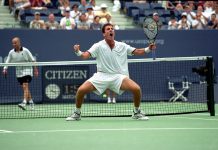Once in a while the nerdiest klutz in school — you know, the one with the pocket protector who’s sitting by himself in the corner — becomes the hippest dude around overnight.
And that’s what’s happened to tennis.
Until the late ’60s, our game was such a nice little pleasantry. Dreamy backhands at leafy clubs: white balls, white clothes, white sensibility. It’s Sunday afternoon — pass the lemonade.
Then — BOOM, ZAM, ZAP — a pop culture tornado hit. The mother of all sports crazes – The ’70s Tennis Boom – exploded across the land. Long before the emergence of Soccer Moms and Desperate Housewives, Tide-and-Prell ladies suddenly began swinging their Wilsons and Princes. Buick and MetLife salesman alike got it. Tennis was a good way to build business. You couldn’t walk down the fruits-and-vegetables aisle of your local market without seeing PTA moms choosing their broccoli in flawless ellesse outfits. No wonder local parks soon sported long lines to get on humble courts and — from Scarsdale to the OC — thousands of tennis clubs sprouted on suburban knolls.
All the while, bigger-than-life characters came to life. Forget Ken Rosewall or Owen Davidson, here was an array of sweaty, fist-rattling (or oh-so-sweet) soap-opera personalities. Jimbo, Mac, Billie Jean, Chrissie, Nasty, Borg and Vitas shook ’em up at the country club. And every possible format blossomed. Not only did Breakfast at Wimbledon become must-see-TV, there was The Battle of the Sexes, winner-take-all showdowns, rowdy World TeamTennis and new tournaments from Hilton Head to Caesar’s Palace. Sleepy ol’ tennis was zooming. But whoa Nellie, the onslaught was too much, too soon. ‘Twas the Wild West out there, the growth spurt was too sudden. Sure, anarchy can be thrilling, but it has its down sides.
Tennis newbies soon realized this was one tough game. You needed a user-friendly opponent and, yeah, losing was a drag. Worse yet, all the enthusiasts were coming to a game that had no idea how to bridle their enthusiasm or where to put them so as to bond with the sport.
Soon the thrill was gone. Soaring expectations floundered. Yard sales were soon crowded with Donnay or Rossignol rackets. Attics began to fill with once nifty tennis outfits. “Don’t throw out those tennis balls, Ethel, Fido loves to chase them.” Reality was catching up. The glorious boom began to go bust. Scoundrels out for a buck crowded a glamorous, easy-entry business. Many a tennis enterprise went south, charismatic stars began to fade. In ’86, Ivan Lendl — complete with his emotionless, Soviet personality – faced the little-known Miloslav Mecir in the U.S. Open final. The suits were in a tizzy. Plus, the build-’em-up-just-to-shoot-’em-down press began to turn. Tennis went from being a media darling to an inviting whipping boy as every two-bit commentator took their best shot. And, of course, never before had there been such a “gotcha” article like Sports Illustrated’s infamous “Is Tennis Dying?” attack piece in ’94.
Can you spell P-A-N-I-C?
Sure, tennis — balkanized and barely governed — had been asleep at the wheel. But it wasn’t about to roll over. After all, it IS a great game — healthy, social, challenging, mental and fun. It’s got a great spectator side, it’s co-ed and international and you can play it until you’re pushing up daisies. So the USTA created a (“let’s roll up our sleeves and get going”) Player Development program.
All the while, the vital and sometimes fierce entrepreneurs in the game put their hefty differences aside and gathered in historical meetings to try and save their suddenly floundering brand. Manufacturers, entrepreneurs, club and resort owners, teaching pros, agents, association execs, tournament directors and media moguls all gathered in Florida. The summit, dubbed “The Spirit of Sarasota” tried to be real. All agreed the sport was reeling. So, the question was how to stop the bleeding? Where’s the vision, what’s the plan?
What emerged was the notion to briefly put aside the zealous quest for one’s almighty market share in order to save the troubled industry. Let’s get involved. So the Tennis Industry Association was born and a wet behind the ears, wonder kid, Kurt Kamperman, was brought in to run the new group. Soon funds were pooled, studies were commissioned and there was a fierce push to penetrate the insular, politics of the then fuddy-duddy USTA. Old-school insurance execs and oilmen were fine gents, but tennis entrepreneurs had long been viewed as hucksters and profiteers who somehow drained the game by making money. This mindset was attacked head on and the bigger than life tennis club exec, Alan Schwartz, the preppy, gadfly publisher Gene Scott and super salesman Jim Baugh were (OMG!) elected to the USTA’s powerful board. The group’s us-against-them sensibility was shattered. Inclusion, diversity, outside-the-box thinking and – get this – adept marketing actually came into play. High powered hires and assorted (“why not try this one”) innovations became commonplace as the U.S. Open established itself as a gotta-be-there carnival and the U.S. Open Series, Hawk-Eye and Diamond Vision became mainstays.
The establishment was now far more willing to debate outside-the-box ideas and embrace feisty folks. Arthur Ashe had long been dismissed as a (“oh, that’s just Arthur”) troublemaker. In ’97, they named their stadium after him. Similarly, Billie Jean King evolved from pain-in-the neck uppity woman to celebrated, inside-the-beltway heroine.
Internally, committee assignments were based more on merit than shrimp-and-chardonnay aplomb. On court, league tennis became a huge hit that attracted legions, while high-level brainstorming turned a once-adrift game into sports’ answer to the New Deal as the USTA and the always watchful TIA launched wave after wave of programmatic initiatives. The Plan For Growth, Play Tennis America, Tennis Welcome Centers, Cardio Tennis, QuickStart, Tennis Night In America, the High School No-Cut initiative all brought — in vastly varying degrees — spit and vinegar to the game.
Of course, up until the early ’90s, no one could even tell you how many people played tennis. That changed. TIA polls were taken, numbers were crunched, microanalysis flourished. Eskimos have a gazillion words for snow. Now tennis geeks were not only bandying about stats on “total play occasions,” they sub-divided participants into definitive categories: new players, continuing players, rejoiners, lapsed players and former players.
Then in ’03, USTA chief Schwartz contended that the key barometer was tennis participation, not the USTA’s membership or its bank account. But, unfortunately those participation numbers were flat or down. Ambitious, but attainable goals needed to be set. There should be growth every year and, by the end of the decade, America’s 23 million tennis players should spike up and break the lofty 30 million mark.
So voila, there was a new vision, new banners and a new slogan: 30 by 2010. Subsequent USTA leaders bought into it all, as Franklin Johnson spent hefty money to energize parks, where so many empty courts invited play. Jane Brown Grimes focused on schools and the USTA’s current leader, Lucy (“We’re All In This Together”) Garvin, stressed the importance of team work and partnership. And, with the help of the USPTA and PTR, it actually worked. Can you believe it? In ’09, there were a record 30.1 million tennis participants in America, up 25 percent from ’03 and 12 percent from ’08. Insiders gleefully scoured the stats. Former players, almost 7 million strong, were coming back to the courts. Retention was key. Tennis was growing among the rich and poor, in suburbs and in the boonies, and among all ethnic groups, especially African-Americans (up 32 percent) and Hispanics (up 19 percent).
While soccer’s growth was flat, basketball, baseball and football were all losing ground. Tennis was the fastest growing traditional game this side of the X-Games or extreme Pilates. The TIA, USTA, teaching pros, club, park and school folks had all come together to push one initiative after another.
“Tennis was built into a wonderful skyscraper and it had great foundations,” noted Schwartz.
Indeed, sickly ol’ tennis, which pundits claimed was wreathing on its deathbed, is now up and blasting outright winners. So thank you, Sally (“The Sky is Falling”) Jenkins, wherever you are. Your “Is Tennis Dying?” gotcha piece really got us going.


















